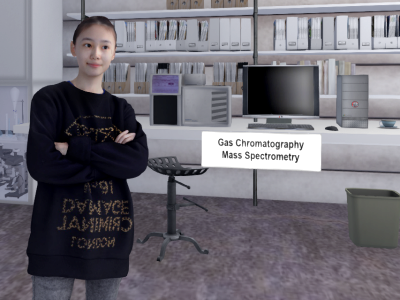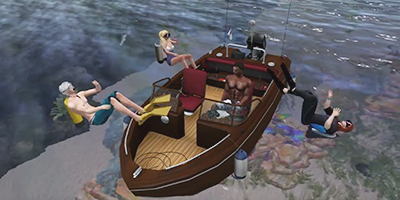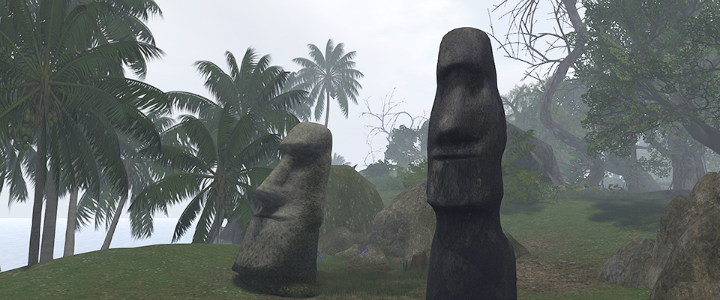Case Study: Environmental Science
How can the student experience be enhanced when resources are tight?
Dr William Landing, of the Department of Earth, Ocean and Atmospheric Science at Florida State University, hoped VLEs might offer an effective way of teaching core science concepts outside of traditional classes and lectures. His colleague Stephanie Dillon, of FSU’s Department of Chemistry, told him about the VLEs we had designed for her introductory course in Chemistry for Liberal Studies, which had led to a dramatic increase in enrollment onto her course, with an equally dramatic retention rate of around 95%.
Dr Landing wanted to try the same approach on his introductory course in environmental science. He hoped that by taking his students on “virtual field trips”, he could enable them to apply what they had learned in his classes to real world scenarios, in an exciting, engaging way that would be impossible without significantly increasing the resource burden on both the students and department.

Project Title: Environmental Science
Client: Dr William Landing, Professor of Oceanography, Department of Earth, Ocean, and Atmospheric Science, Florida State University.
Objective: to enhance student experience without significantly increasing the resource burden on both the students and department.
Summary: a series of modules in which students apply scientific methodologies while studying and assessing environments. Students explore places they would not have the opportunity to visit as part of a traditional course, including a scientific facility in Antarctica, Easter Island through the ages, and a marine biology research centre and its surrounding coral reef.
Outcome: student satisfaction improved; enrollment increased by 50% in Fall 2017 compared to the previous year. It currently stands at 700 per year.
As an educator, VLEs are fantastic. In the environmental science lab we have them SCUBA diving on the Great Barrier Reef — we could never do that — and I do it too! I’m in the environment with the students, our TAs are in there, interacting too.
Videos for all our courses are available on our YouTube channel.
Modules
The course comprises the following modules:
1. Easter Island
2. Invasive Species
3. Ice Core
4. Climate Change and Ocean Acidification
5. Nutrient Use on a Farm
6. Nutrient runoff: watershed impacts
7. Frogs and Atrazine
8. Green Building


Design
Working with Dr William Landing, we devised and built a laboratory series consisting of eight modules taught within four VLEs. Students travel back in time to Easter Island with the mission of discovering what caused the collapse of the Rapa Nui culture. They monitor invasive species by SCUBA diving on the Great Barrier Reef and analyze the Earth’s climate change by drilling ice cores in the Antarctic. The last environment is closer to home: a suburban housing development in which students learn about the design, construction and maintenance of sustainable buildings.
Modules
1: Easter Island
Students travel to Easter Island at six different times in history, from 900AD to 1800AD. They measure the changes in, and the relation between, the island’s resources and its population, tracing the effect of the increasing population on the environment and its collapse once the island’s resources have been exhausted.
2: Invasive Species
On a small tropical island, students are introduced to invasive/non-native species. Diving underwater, they collect and record data on fish species, algae coverage, and coral coverage over different time periods. They are taught the various methodological approaches and techniques used to survey marine biodiversity (Line Transect, Quadrant Sampling, and S Transect).
3: Ice Core
Students join a scientific expedition in Antarctica, where they drill for ice core samples in a snow-swept landscape, before analysing the samples in a field lab. They add the data they collected in the virtual environment to an existing ice core data file that goes back almost 800,000 years. They use the dataset to inform a discussion of how changing CO2 levels might affect the Earth’s climate.
4: Climate Change and Ocean Acidification
Returning to the tropical island, students conduct a survey on a coral reef. They learn about coral symbiosis, how atmospheric CO2 affects seawater pH levels, how calcium carbonate dissolves in low pH, and how to design a field experiment (including controls, experiments, and replicates). They also discover that every field experiment affects the environment on a small scale.
5: Nutrient Use on a Farm
After initial instruction in a large industrial barn, students visit wetlands capable of growing sugarcane. Students must determine the amount of fertilizer required to produce a healthy and commercially profitable sugarcane crop. They learn why fertilizers are used, gain an understanding of yields and nutrient use efficiency, and practice basic data analysis techniques.
6: Nutrient Effect on a Watershed
Students visit six virtual watersheds in various states of eutrophication, and take dissolved oxygen readings and water samples for analysis and processing. Then they explore issues associated with eutrophication, learn how to relate fertilizer inputs to eutrophication effects, and estimate the cost of eutrophication to a farm.
7: Frogs and Atrazine
On a tropical island, students experiment on frog species using Atrazine. As well as practicing a variety of basic laboratory techniques, students are introduced to the issues surrounding environmental toxicology, and the dangers posed to vulnerable populations by human-made chemicals. They also learn about experimental and control treatments, and how to evaluate their results statistically.
8: Green Building
Within a suburban housing development, students detect and identify building features, fixtures and fittings that can be made more energy efficient using a ‘green scanner’. This introduces the basic principles of sustainable building and its benefits. It also teaches students how to assess different building materials according to green criteria, and enables them to evaluate the cost-effectiveness of different building choices.
Outcome
Dr Landing and his students are delighted with the project. Using VLEs, he presents the course material in a far more engaging way, without forfeiting the educational standards required of a core science class.The course is currently offered year-round and attracts approximately 750 new students annually.
CONTACT US
hello@cndg.info
Tel (US): +1 (855) 553 8726
Tel (UK): +44 (0) 207 193 2412
my.cndg
client support: help@cndg.info
© Chant Newall Development Group, LLC. All rights reserved. CNDG™ is a registered trademark of Chant Newall Development Group, LLC.
